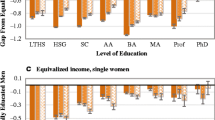Abstract
This paper provides an empirical investigation of a theoretical model of the marriage market. In the model, women are valued more for their ability to bear children and men are valued more for their ability to make money. Men cannot reveal their labor market ability to potential spouses until they enter the labor force. At the same time, the relevant information for evaluating females as spouses is revealed at a younger age. The model predicts that the income of males will be positively associated with age-at-first-marriage. We find empirical support for the model. However, we also find the association between male earnings and age-at-first-marriage becomes negative for those who married after age 30, which was not predicted by the model. Consistent with the model, we do not find a strong relationship between earnings and age-at-first-marriage among females.
Similar content being viewed by others
References
Bagnoli M, Bergstrom T (1993) Courtship as a waiting game. J Polit Econ 101:185–202
Becker G (1981) A treatise on the family. Harvard University Press, Cambridge, MA
Becker G (1973) A theory of marriage: Part I. J Polit Econ 81:813–846
Becker G (1974) A theory of marriage: Part II. J Polit Econ 82:S11-S26
Benham L (1974) Benefits of women’s education within marriage. J Polit Econ 81:S57-S71
Cornwall C, Ruppert P (1991) Unobservable individual income effects, marriage and the earnings of young men. SUNY Buffalo Working Paper
Keeley M (1977) The economics of family formation. Econ Inquiry 15:238–250
Kenny L (1983) The accumulation of human capital during marriage by males. Econ Inquiry 21:223–231
Korenman S, Neumark D (1991) Does marriage really make men more productive. J Human Resources 26:282–307
Korenman S, Neumark D (1990) Marriage, motherhood, and wages. NBER Working Paper No. 3473
Lam D, Schoeni R (1993) Effects of family background on earnings and returns to schooling: evidence from Brazil. J Polit Econ 101(4):710–740
Schwarz G (1978) Estimating the dimension of a model. Ann Statist 6(2):461–464
United Nations Department of International Economic and Social Affairs (1990) Patterns of first marriage: Timing and prevalence. United Nations, New York
Vella F, Collins S (1990) The value of youth: equalizing age differentials in marriages. Appl Econ 22:359–373
Welch Finis (1974) Benefits of women’s education within marriage. J Polit Econ 81:S72-S75
Author information
Authors and Affiliations
Rights and permissions
About this article
Cite this article
Bergstrom, T., Schoeni, R.F. Income prospects and age-at-marriage. J Popul Econ 9, 115–130 (1996). https://doi.org/10.1007/PL00003834
Received:
Accepted:
Issue Date:
DOI: https://doi.org/10.1007/PL00003834




